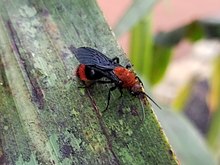| Dasymutilla occidentalis | |
|---|---|

| |
| Female | |

| |
| Male | |
| Scientific classification | |
| Domain: | Eukaryota |
| Kingdom: | Animalia |
| Phylum: | Arthropoda |
| Class: | Insecta |
| Order: | Hymenoptera |
| Family: | Mutillidae |
| Genus: | Dasymutilla |
| Species: | D. occidentalis |
| Binomial name | |
| Dasymutilla occidentalis (Linnaeus, 1758) | |
| Synonyms | |
|
Mutilla occidentalis Linnaeus, 1758 | |
Dasymutilla occidentalis (red velvet ant, eastern velvet ant, cow ant or cow killer) is a species of parasitoid wasp that ranges from Connecticut to Kansas in the north and Florida to Texas in the south. Adults are mostly seen in the summer months.
The eastern velvet ant is the largest of the velvet ant species in the eastern United States, attaining an approximate length of 0.75 in (1.9 cm). Adults display aposematic coloration, consisting of black overall coloring with an orange-red pattern on the dorsal surface of the thorax and abdomen.
Characteristics and description
Commonly mistaken for an ant because of its appearance and its common name, it is a parasitoid wasp species in which the females are wingless, as is true for all females of Mutillidae. It can be recognized by its distinctive coloring, black with bright red on the upper side of the head, thorax, and abdomen. They are quick-moving and often take a defensive posture when threatened. Unlike the females, males have dark, translucent wings and do not possess a stinger.
Ecology
Dasymutilla occidentalis plays an ecological role as parasites, and prey.
Defense
Dasymutilla species have multiple defensive strategies, but are best known for their extremely painful sting, ranked 3 out of 4 on the Schmidt's sting pain index, earning them the nickname of "cow killer". Cow killer defenses include a thickened exoskeleton, the ability to run fast and evasively, warning coloration, stridulatory warning sounds, a chemical secretion, and venom. Both sexes make a squeaking noise (stridulation) to warn potential predators (another form of aposematism in females, and automimicry in males). When stridulating, velvet ants rub their abdominal segments together in a rapid fashion. This is different than stridulation seen in insects such as crickets, in which the leg structures are rubbed against the abdomen.
D. occidentalis and related species are well known for their Mullerian mimicry. Mullerian mimicry occurs when species with pre-existing defenses adopt similar colorations and patterns to increase the fitness of all species involved. North American velvet ant species comprise one of the most intricate Mullerian mimicry rings in the natural world, being divided into eight separate rings of mimicry. Their behavior and coloring has been used to study how aposematic coloration works in the wild.
Reproduction and life cycle
Like most wasp species, velvet ants live solitary lives. Males take to the air to detect pheromones released by females. Males will fly towards female stridulation sounds as well. Once a receptive female is located, the male will carry the female in his mandibles and move her to a place he deems "safe" to mate. These mating spaces are often shaded and away from potential mating competitors. Both males and females stridulate during the mating process. Once the mating process is finished, the female begins looking for eggs and larvae of host species. Females are believed to mate only once in their lifetime.
After mating, females seek out the brood cells of Eastern cicada killers and horse guard wasps as well as other large ground-nesting members of Crabronidae, where they sneak into the nest and deposit an egg onto a host larva. The egg quickly hatches into a white, legless grub, which consumes the host larva and goes through several larval stages prior to pupation. Pupation typically takes 23 days.
References
- "Dasymutilla occidentalis (Linnaeus)". Global Biodiversity Information Facility. Retrieved 11 May 2023.
- ^ "Species Dasymutilla occidentalis". Bugguide. Iowa State University. Retrieved September 12, 2011.
- ^ "Red Velvet Ant or "Cow Killer"". Texas AgriLife Extension Service: A Field Guide To Common Texas Insects. Texas A&M University. Archived from the original on September 2, 2011. Retrieved September 12, 2011.
- ^ "Red velvet ant; cow killer". Arthropod Museum. University of Arkansas: Division of Agriculture. Archived from the original on May 26, 2012. Retrieved September 12, 2011.
- Smith, Caleb. "Dasymutilla occidentalis". Animal Diversity Web. Retrieved 2024-04-20.
- ^ Jackman, John. "Venomous Terrestrial Animals of Texas" (PDF). Texas A&M University System.
{{cite journal}}: Cite journal requires|journal=(help) - Gall, B. G.; Spivey, K. L.; Chapman, T. L.; Delph, R. J.; Brodie Jr, E. D.; Wilson, J. S. (2018). "The indestructible insect: Velvet ants from across the United States avoid predation by representatives from all major tetrapod clades". Ecology and Evolution. 8 (11): 5852–5862. doi:10.1002/ece3.4123. PMC 6010712. PMID 29938098.
- ^ "Velvet Ant (Cow Killer Ant) | Nebraska Extension in Lancaster County". lancaster.unl.edu. Retrieved 2023-09-27.
- ^ Schmidt, Justin O.; Blum, Murray S. (1977). "Adaptations and responses of Dasymutilla occidentalis (Hymenoptera: Mutillidae) to predators". Entomologia Experimentalis et Applicata. 21 (2): 99–111. doi:10.1111/j.1570-7458.1977.tb02663.x. ISSN 1570-7458. S2CID 83847876.
- ^ "Velvet ants: flamboyant and fuzzy with extreme PPE". www.nhm.ac.uk. Retrieved 2024-02-21.
- Wilson, Joseph S.; Williams, Kevin A.; Pitts, James P. (2010). "Preliminary Assessment of Velvet Ant (hymenoptera: Mutillidae) Diversity in the Deserts of Southern California". Western North American Naturalist. 70 (2): 224–232. doi:10.3398/064.070.0209. ISSN 1527-0904. JSTOR 41717897.
- ^ Smith, Caleb. "Dasymutilla occidentalis". Animal Diversity Web. Retrieved 2024-02-21.
External links
 Media related to Dasymutilla occidentalis at Wikimedia Commons
Media related to Dasymutilla occidentalis at Wikimedia Commons
| Taxon identifiers | |
|---|---|
| Dasymutilla occidentalis | |